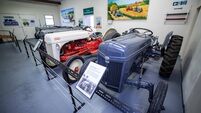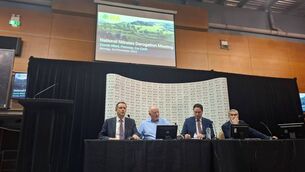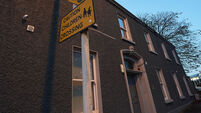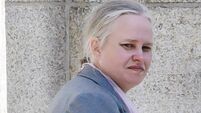All-time high for Irish farming
AGRICULTURE is in a confident mood at present. Data which confirms such an outlook was presented at a conference organised by the Rural Economy research arm of Teagasc in Portlaoise last week. The margins per hectare for different enterprises were examined, with results for 2010, based on the National Farm Survey, and estimates for 2011.
These results generally indicate a return to 2008 levels of profitability (a good year) in 2010, with 2011 forecast margins at similar levels (improved in dairying). The data also shows quite how awful 2009 margins were for most enterprises. The percentage increases in margins look impressive, but predominantly reflect the lows of 2009. Average family farm income in 2010 is expected to show a 40% increase on 2009.
While 2010 output prices look like holding into 2011, there will be a significant increase in costs, which will make maintenance of margins difficult. The pigmeat sector has particular difficulties and is already making losses, with little short term prospect of an improvement in prices.
* Dairy: Millk production rose by 8% in 2010 (almost filling the quota — no scope for similar increases for a while yet). Costs of dairy production per litre fell as a result. Costs per hectare increased by about 4%, as greater volumes of feed were used (up 12%). In 2011 it is expected that costs will rise by about 4% again, with feed expenditure up 15%, due to higher prices, and forage costs up 8% (higher prices but lower volumes).
The world dairy market began to recover at the end of 2009, due to improved demand, particularly from China. This was maintained throughout 2010, when globally there was a weak response to higher prices and in particular limited exports from New Zealand. As a result Irish milk prices in 2010 were up by 30% on 2009 — from 23.1 cents per litre to an estimated 29.7 cents. These prices are expected to remain firm at least until the middle of 2011, giving a further milk price increase of 5% to 10% in 2011.
With production costs down and output prices up by 30%, average net margin was up by a whopping 1030% in 2010. In 2011 it is expected that margins will grow by a further 7% to 15%, depending on the size of the milk price increase. (see graph).
* Cattle: Costs of production were broadly similar in 2010 to 2009; concentrate volume was up but prices were lower, fertiliser prices were down 17% but applications were up, fuel was also dearer. Cost per hectare in most beef systems declined by about €6 per hectare. In 2011 it is expected that expenditure on concentrates will increase by 8%, on fertiliser by 9%, on fuel by 12% and on contracting charges by 5%, leading to an overall increase in costs of €23 to €28 per hectare. Cattle prices in 2010 were up 2% on the previous year and are expected to improve by 4% in 2011, partly because beef production in the EU is falling. However when account is taken of increased costs cattle margins in 2011 are expected to show a small decline. The unprofitability of cattle farming will continue. Over 80% of Irish cattle farms (70,000) show a negative net margin for 2010.
* Sheep: Expenditure on feed on sheep farms increased by 4% in 2010 and is expected to rise by 8% in 2011. Expenditure on fertiliser declined by 13% in 2010 but is expected to increase by 20% in 2011, leading overall to a slow creep upwards in overall costs.
In 2010 and 2011, European production of sheep is in decline, while consumption is stable and imports are static. Irish lamb prices were up 17% in 2010, partly as a result of these overall market conditions and partly because of improved competitiveness of the euro with sterling, which resulted in higher returns on UK markets and improved competitiveness vis-a-vis British lamb on continental markets.
Overall gross margins in sheep production were up 47% in 2010, and are expected to show a modest decline of about 3% in 2011.
* Pigs : The pig sector is the one sector with a tale of woe at present. The cost of composite feed has increased by €71 per tonne between June 2010 and January 2011, representing an increase of €5.7 million per month in the feed bill. This increase is related to increases in cereal and soya prices over the same period and further increases are expected.
Reduced supplies of cereals from Russia, where a ban on exports has been introduced, and strong demand from China have caused these increases. The feed cost per kg of pigmeat has increased from 87 cents in the first half of 2010 to 98 cents in the second half, to 113 cents in January 2011, with a possible rise towards 120 cents by March.
Total costs are estimated to have increased from 133 cents in 2010 to 153 cents in January 2011. Pig prices, however, have not responded and producers are incurring substantial losses at present, which may continue for several months. Reduced supplies are expected in the EU from June 2011 as in the six main producer countries, sow numbers had fallen by over 2%, and sow slaughtering had increased, even before the increase in feed prices.
This places Irish pig producers in a situation of requiring substantially increased working capital to survive, until prices recover. They could be in serious difficulty if the banks, in their present difficulties, refuse requests for extra capital.
* Cereals: The area devoted to cereals in 2010 was 11% down on 2009. Yields were higher; with spring barley yields up about 10% and winter wheat up about 6%. There was a decrease in moisture levels of 1 percentage point for barley and 2 points for winter wheat.
Overall production was down 2.6% on 2009 levels, but when account is taken of the reduced moisture the overall fall is only 1.5%.
Cereal prices received by farmers were up over 60% on 2009. This arose because of decreased production worldwide, arising from the low 2009 prices, weather conditions during the growing season and export bans from exporting countries such as Russia, where there was a drought. The fall in the value of the euro relative to the dollar was also a factor.
Costs incurred by cereal farmers in 2010 were generally down, with seed down 25%, fertilisers down 25 to 30% and land rent down 5%, while energy costs increased by 22%. This combined with the better market prices led to a substantial increase in prices received, and to dramatic increases in gross margin, compared with the low levels of 2009, with winter wheat gross margin up by €600 per hectare and spring barley up by €550.
In 2011, cereal prices are likely to remain strong and a 5% increase is forecast. Stocks remain low and the export restrictions remain in place.
Costs are however likely to increase, particularly for fertilisers, and a slight reduction in overall margins is forecast for 2011.
* Capital situation on Irish Farms: the average debt level on Irish farms in 2009 was about €20,000, with the average for cattle and sheep farms being below €10,000, but the level on dairy farms being close to €50,000. Almost 40% of all farms have no debt at all. The average debt on those dairy farms which have debts was ca €80,000, with the corresponding figures for beef, sheep and tillage farms, being €35,000, €20,000 and €50,000 respectively.
Of those farms which have borrowings, the average ratio of debt to income is 2:1. Interest payments accounted for about 12% of income on these farms in 2009. This fell to about 9% in 2010. Dairy sheep and tillage farms benefited but cattle farms did not.













